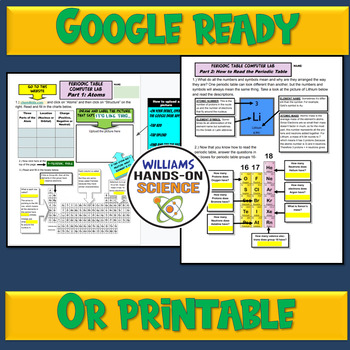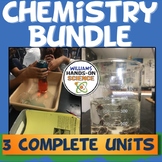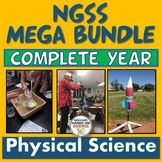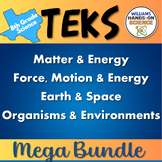Periodic Table of Elements Computer Activity Worksheets MS-PS1-1 HS-PS1 Digital
- Zip
Also included in
- This NGSS bundle has everything you need for Structure and Properties of Matter (complete distance learning unit), PS1.B PS3.A Chemical Reactions Google Ready Bundle (complete distance learning unit) Chemical Reactions, Definitions of Energy, States of Matter, Periodic Table, Chemical Reactions, ConPrice $69.97Original Price $115.20Save $45.23
- This bundle is a time-saving, comprehensive and user-friendly complete year bundle for physical science Teachers that will streamline your teaching experience effortlessly! Every lesson is meticulously planned and just a click away. This extraordinary bundle is a treasure trove of engaging resourcesPrice $176.00Original Price $311.50Save $135.50
- The TEKS 8th Grade Bundle is a comprehensive resource for teaching science mainly in Texas, but it can be used in any state. This bundle includes over 60 hands-on, rigorous, engaging, and phenomena-driven lessons that cover the TEKS standards for 8th grade science. The lessons are designed to help sPrice $160.00Original Price $321.15Save $161.15
Description
This assignment is NO prep and it’s totally student centered. I use it to front load and introduce the periodic table. If you’re comfortable with a substitute and computers, it can be a great sub plan or you can use it for review. High school chemistry teachers can use it as an intro and then go more in depth later. After this assignment I have my students do my “Periodic Table Baby Book” and the Atom Model Project, to become even more familiar with specific elements and their characteristics. The only materials you need are computers and colored pens or pencils and that’s it! It’s approximately a 1 to 2-hour activity depending on grade level.
THE RESOURCE IS NOW GOOGLE READY!!!
This resource includes the following:
-9 slide Google Slideshow
-PDF Printable version
-PDF Printable Key
These concepts are included:
Element Name
Element Symbol
Atomic Number
Atomic Mass
Word Bank for ELL and SPED
# of protons
# of electrons and Valence electrons
# of neutrons
Group/Family Name and characteristics of each family
Alkali Metals, Alkaline Earth Metals, Transition Metals, Non-Metals, Noble Gases, Halogens, Rare Earth Elements and Metalloids
How to Read the Table
Structure of atoms
How to calculate Protons, Neutrons and Electrons
Number of orbitals and/or shells
TERMS OF USE
• All rights reserved by Williams Hands On Science, Inc.
• This product is to be used by the original purchaser only.
• Intended for classroom and personal use only.
• Copying for more than one teacher, classroom, department, school, or school system is prohibited.
• This product may not be distributed or displayed digitally for public view.
• Failure to comply is a copyright infringement and a violation of the Digital Millennium Copyright Act (DMCA).
If there are any errors or questions, please contact me through TpT or email me at:
williamshandsonscience@gmail.com
Thank you for taking a look!
Please follow me on TpT for new products and check me out on Instagram for my products in action!
https://www.instagram.com/williams_hands_on_science/
Or buy my Chemistry Bundle and save lots of money!!!
Flipping the Classroom Periodic Table Frayer Models








